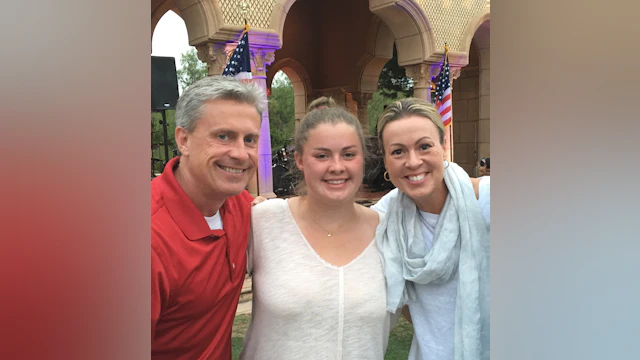Nothing can prepare a parent for the death of a child. The sorrow is indescribable, causing pain that punches your soul and leaves you breathless. When a child dies by suicide that sorrow is heavy with guilt, shame, and the feeling that you will never be able to make sense of what has happened.
As parents, my husband and I have tried to pick up the pieces and rebuild — to find a way forward. However, the landscape of our lives is totally different and unfamiliar. We must navigate in the dark sometimes, yet still we know there is light and so much life to live.
There will always be negative space — a shadow looming over life. That is how it is after such great loss: No matter what is built from the ashes, there will always be a hole that can’t be filled. Our daughter Jessica thought we would be “better off without her” — that we would be sad for a while but eventually we would move on and our lives would be better. This may be the greatest lie of the suicidal mind.
Jessica’s story is complicated: Like an onion with each new layer revealing her pain, raising new questions without any answers and exposing what we can’t help but feel was a failure on our part, as her parents, to have helped her navigate her precarious mental health. Her suicide detonated a bomb in our lives, leaving each of us feeling shattered and destroyed.
In the days, weeks, months, and years since Jessica’s suicide, we became aware of what struck as systemic failures within our family, our religious community, the broken medical system, and what we felt to be failures of the university she attended. After her death, we learned of the school’s inadequate mental health resources on campus, the lack of ‘best practice’ prevention or postvention resources (i.e., how to best handle things if a suicide should occur) for students and families, as well as the manner in which the university seemed to hide student suicides from public view. People and institutions often mistakenly think it’s safest not to speak about this manner of death, which only serves to increase shame and discourage help-seeking. We were frustrated by the lack of safety nets for when a student shows all the signs of drowning in the deep waters of a mental health crisis. Complicating things further, the very law that is meant to protect student records (FERPA) can stymie the sharing of communication when professors and other members of the school community recognize that someone is in crisis.
The problem is real. In colleges and universities in the United States, suicide is one of the most common causes of death among students. Each year, approximately 24,000 college students attempt suicide. 1,100 students do not survive their crisis, making suicide the second-leading cause of death among U.S. college students. Yet research shows that suicide is often preventable.
Thanks to the American Foundation for Suicide Prevention (AFSP), many college campuses across the country have implemented programs and best practices for suicide prevention and postvention, which make a positive difference. You can learn about how to bring suicide prevention to your school here.
Because we believe in AFSP and feel strongly that more must be done to fight this leading cause of death, especially when it comes to our young people, our company, Moxie Pest Control, has announced a $100,000 contribution to AFSP to help support its mission to save lives and bring hope to those affected by suicide.
While there will always be a hole in our hearts, I have hope for positive change. With organizations like AFSP and the wisdom of other survivors of suicide loss, it is my deepest wish that we can continue to help make an impact on how college campuses approach those at risk for suicide.

MORE INFORMATION ON SUICIDE PREVENTION RESOURCES FOR SCHOOLS AND YOUNG PEOPLE
AFSP offers a host of resources to help you learn more about mental health and suicide, and spread awareness in your communities and school districts:
Suicide Prevention Resources for Schools: AFSP offers foundational suicide prevention tools for schools to adopt and implement. Programs like It's Real and More Than Sad provide mental health education and resources, while the Model School District Policy on Suicide Prevention outlines best practices for school districts to protect student health and safety.
How Parents and Guardians Can Help Prevent Teen Suicide: Parents and guardians can play a role in suicide prevention by learning about the research and resources surrounding teen suicide, and how they can have healthy and productive conversations with their children. Parents and guardians can also participate in AFSP's program More Than Sad: Parent Education, and learn to recognize the signs of depression, start conversations about mental health with their children, and help get them connected to resources.
A Guide for Schools Navigating Suicide Loss: After a Suicide: A Toolkit for Schools offers reliable information and practical tools that can help schools to support grieving and distressed students, parents and guardians, and school staff, while also communicating safely, responsibly, and proactively with the public.
For Adults Supporting Young Loss Survivors: Written in partnership with Dougy Center, The National Grief Center for Children & Families, AFSP's Children, Teens, and Suicide Loss booklet offers concrete guidelines for adults who want to offer the best possible support to young loss survivors coping with grief and navigating a path toward healing. Adults supporting young loss survivors can also read these two articles by Dr. Pamela Gabbay, a childhood bereavement consultant and part of AFSP's Suicide Bereavement Support Group Facilitator Trainings program. The articles outline what to expect when a teen or young child returns to school after a suicide loss, and what parents or guardians can do to help them navigate the experience.